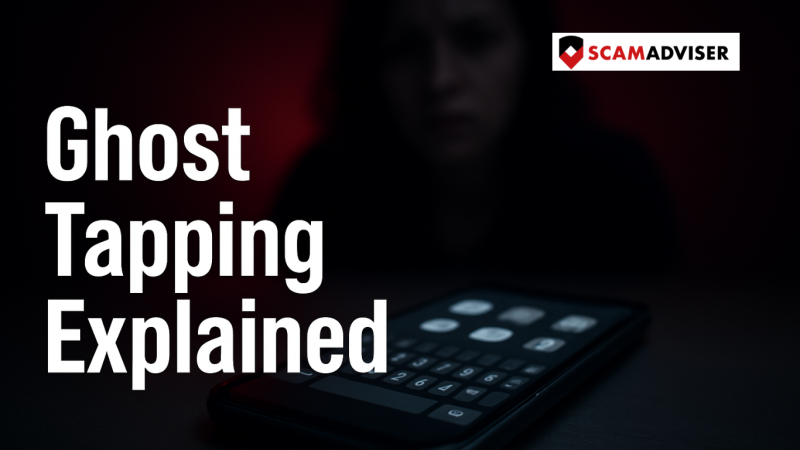Menu

Just when you thought you’d seen every trick in the scammer’s playbook—along comes something new, spooky, and high-tech. It’s called ghost tapping, and it’s quickly becoming one of the most unsettling digital scams out there.
Why “ghost”? Because your phone seems possessed. Buttons get pressed, apps open, money moves—yet you didn’t touch a thing.
In a nutshell: Ghost tapping is a new scam where fraudsters secretly control your phone through hidden malware. It lets them make taps, authorize payments, or access your private data without you touching your screen. It usually starts when you click a fake link or install a dodgy app. Protect yourself by avoiding unknown links, using official app stores, and keeping your phone’s software up to date.
Ghost tapping refers to a type of digital attack where your phone registers “phantom” touches—meaning actions happen on your screen without you physically touching it. Technically, this control is often achieved using a Remote Access Trojan (RAT) or by abusing accessibility services built into mobile operating systems.
This isn’t some glitch or screen defect. In many cases, it’s malware, planted by scammers to gain control of your device. Once inside, they can do almost anything you can do:
It’s called “ghost tapping” because the taps look invisible—almost like a ghost is operating your phone. Creepy, right?
Most ghost tapping scams begin the same way: with a fake link or malicious app.
You might receive a text, email, or social media message saying something like:
The link looks legit—maybe even branded with your bank or a known company—but once you click it, it installs hidden software that gives scammers remote access to your screen.
Sometimes, it’s not even instant. The malware might wait days before activating, making it harder to trace where it came from.
Once scammers have control, the chaos begins. They can approve online payments, extract data, or manipulate apps while you’re none the wiser. Some victims have even watched in real time as their screens moved on their own—icons flicking, screens scrolling, and money disappearing.
For many, the first sign of ghost tapping is unusual activity—bank alerts, apps opening by themselves, or phone performance suddenly slowing down.
To keep your digital life secure, follow these five essential steps to prevent malware from hijacking your phone:
Always download applications exclusively from the Google Play Store (for Android) or the Apple App Store (for iOS). Third-party app sites are hotbeds for fake, infected software and are the primary source for installing hidden malware. Even if an app looks legitimate, never install software from an unknown browser link.
Think before you click. If you receive a text, email, or social media message that sounds urgent, emotional, or offers something "too good to be true," stop and think. That sense of panic or rush is exactly what scammers want. Manually type the company’s website into your browser instead of clicking the link provided.
Software updates aren't just for new features; they are critical security patches. Updates patch security loopholes and zero-day vulnerabilities that hackers are quick to exploit with new malware. Make sure your phone's operating system (iOS or Android) and all your apps are configured to update automatically.
Two-factor authentication (2FA) is your last line of defense. Even if scammers manage to gain access to a password, 2FA will prevent them from completing logins or high-value transactions without the second code, which they usually cannot access. Enable it on banking, email, and social media accounts.
A good, trusted mobile security tool can run in the background, constantly monitoring for suspicious activity. It can detect and block malware, including Remote Access Trojans, before they wreak havoc and give scammers control over your screen.
FAQs
Q: Is ghost tapping caused by a broken screen?
Sometimes, physical screen damage can cause random touches—but ghost tapping scams are different. They’re caused by malicious software, not hardware issues.
Q: Can scammers really move my phone screen remotely?
Yes. If malware is installed, scammers can simulate touches, open apps, and authorize actions—all without you knowing.
Q: How do I know if I’ve been infected?
Watch for strange behavior—apps opening on their own, new permissions, or transactions you didn’t approve. Run a malware scan immediately.
Q: What should I do if I suspect ghost tapping?
Disconnect from Wi-Fi and mobile data right away. Back up your data, then run a full device reset or take your phone to a trusted technician.
Scams are no longer just about fake texts or emails—they’re invading your screen itself. Stay alert, think before you tap, and remember: your best defense is awareness.
Before you click or install anything suspicious, run a quick check with the ScamAdviser App. It only takes seconds and could save you a fortune.